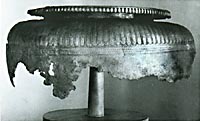|
In Classical Athens cremation of the dead was, at least until
the fourth century B.C., a burial practice of limited frequency.
Two types of cremation need to be distinguished: primary
and secondary. In primary cremation the corpse was reduced to
ashes inside the grave; in secondary cremation it was incinerated
on a pyre outside the grave and the ashes were then buried in a
clay (or metal) urn. Primary cremation had made its appearance by
the Archaic period; it was secondary cremation, however, which
was the commoner practice of the two and where there is greater
variety in the types of ash urn
used. Clay ash urns were pots, either without any decoration or painted in the
red-figure
style. Normally they were not purpose-made for burials, but had previously served as
household utensils.
|  |




